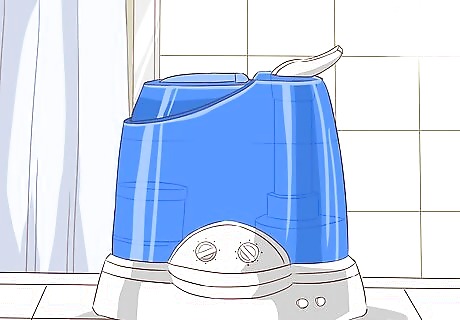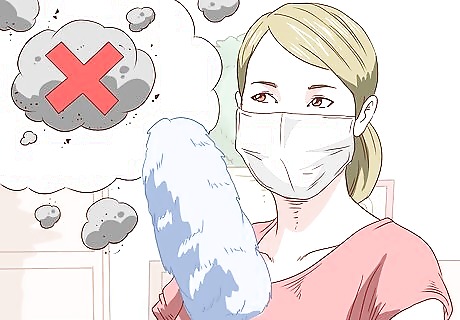
views
Trying Rinses, Rubs and Sprays

Gargle with warm salt water. This is one of the oldest remedies for a sore throat, and it works like a charm. When your throat is sore, the mucous membranes are swollen and inflamed, causing the feeling of pain and scratchiness. Salt draws water from the mucous membrane cells, reducing swelling and helping your throat feel better. Make a saltwater rinse by mixing 1/2 teaspoon table salt with 1 cup of warm water. Don't just rinse your mouth out with the saltwater - gargle it. Tip your head back and make sure it hits the back of your throat, since that's the part that's inflamed. Gargle for about 30 seconds before spitting out the rinse. You can gargle salt water up to 3 times per day. Using the rinse more often could end up drying out the mucous membranes too much, leading to increased irritation. Try adding a drop of bergamot essential oil to the salt water to soothe your throat even more.

Make a hydrogen peroxide rinse. Hydrogen peroxide is a mild antiseptic that can relieve throat irritation. Bottles of the substance are available over-the-counter at drugstores. To make a rinse, follow the instructions on the packaging, which will usually direct you to dilute a capful of hydrogen peroxide in a cup of water. Put the mixture in your mouth and swish it around so that it hits the back of your throat. Spit it out after one minute. Use a solution of 3% hydrogen peroxide. This should be clear on the label of the bottle you buy. Hydrogen peroxide has a bitter taste. You can add a little honey to the mixture to make it easier to rinse if you'd like. The hydrogen peroxide may bubble in your mouth--that’s normal.

Use a vapor rub. Vapor rubs contain aromatic decongestants like menthol or peppermint that soothe the throat and help cut back on coughing. The decongestants are mixed with petroleum jelly to create an ointment. Pick up a vapor rub at the drugstore and rub some on your throat and chest to help you breathe more easily and cough less. You can also make your own vapor rub in the following way: Melt 1 tablespoon of beeswax in a double boiler Stir in 1/2 cup coconut oil. Add 10 drops of peppermint oil Pour the mixture into a glass container and let it cool before using.

Make a mustard plaster. Using a plaster to soothe a sore throat and relieve congestion is an old home remedy. It's particularly useful if you have a deep cough and the soreness extends into your chest. Ground mustard is said to bring warmth and circulation to the chest and throat area. Try out a small bit of the plaster first to make sure you don’t have a bad reaction. Mix 1/2 teaspoon mustard seed powder and 1 tablespoon of flour. Add enough water to make a thick paste. Spread the mixture onto a paper towel. Sandwich the paper towel between two clean pieces of cotton, such as dish cloths. Place the plaster on your throat and chest, making sure the mustard mixture never actually touches your skin. Leave it in place for 15 minutes, or until the skin becomes warm and rosy.

Use throat spray or lozenges. Throat spray and lozenges both contain ingredients that help to soothe the throat and open the nasal passages. Look for honey-based lozenges that contain menthol or peppermint. You can also get medicated spray or lozenges, which have a mild anesthetic to gently numb the throat area and relieve pain.

Take pain relief medication. Non-steroidal anti-inflammatory drugs (NSAIDs) like ibuprofen or acetaminophen can help ease the inflammation that leads to throat pain. Be sure to take no more than the recommended dosage on the packaging. Aspirin is associated with a rare condition called Reye's syndrome, so be cautious when you give it to children and teens. You might try sucking on a small aspirin tablet (81.5mg) for relief. This dosage does not increase risk of Reye’s syndrome. Children and teenagers recovering from the flu or chickenpox should never be given aspirin. In general, children should not be given aspirin unless there is no other medication available. Alternatives like tylenol work just fine.
Drinking Soothing Fluids

Make a honey, cayenne drink. Honey is an important ingredient to include in teas and other drinks you make when you have a sore throat. Studies support what people have found to be true for centuries: it coats the throat and eases inflammation, as well as helping to suppress coughing. Cayenne is another sore throat-fighting powerhouse: it contains capsaicin, a natural substance found in peppers that acts as a pain reliever. Make a soothing, healthful drink by adding 1/2 teaspoon ground cayenne pepper and 1 teaspoon honey to 1 cup of boiling water. Let the mixture cool, then sip it slowly. If you're very sensitive to hot peppers, reduce the amount of cayenne to 1/8 teaspoon or less. Honey should not be given to children under the age of 1, as it has been known to give babies botulism. If you swap out the cayenne for one ounce of whiskey and add some extra lemon, this drink becomes a hot toddy.

Make chamomile tea. Scientific research has shown chamomile, a fragrant flowering herb that people have been using for centuries to beat sore throats and colds, does indeed contain substances that fight infection and relax muscles. Brewing up a few cups of chamomile tea each day you have a sore throat will relieve your throat pain and help you feel more relaxed. Chamomile tea is particularly soothing just before bed, since it will help you sleep a little better. Chamomile tea is widely available in supermarkets. Check the ingredients and choose a box made with pure chamomile flowers, or one in which chamomile is one of the main ingredients. Follow the instructions to brew your tea. Add a spoonful of honey and a squeeze of lemon (an astringent that helps to shrink swollen tissue) to make your tea even more beneficial.

Try garlic broth. Garlic is thought to have antiseptic and antibacterial properties, as well as the power to fight infection and build up the immune system. While its medicinal benefits have not yet been substantiated by scientific research, many holistic health practitioners recommend taking it to soothe sore throats and fight respiratory infection. Make a savory garlic broth to ease your throat irritation by peeling and crushing 2 garlic cloves and pouring a cup of boiling water over them. Add a pinch of salt to make the drink even more beneficial for your throat. If you love the taste of garlic, you can receive the same benefits by simply peeling a clove, crushing it, and sucking on it for a few minutes. If you aren’t a fan of garlic’s distinct taste and smell, try taking garlic tablets instead.

Drink licorice cinnamon tea. Licorice contains chemicals that are thought to ease sore throats by thinning the mucous membranes and decreasing swelling. Licorice-flavored candy doesn't contain high enough concentrations of these chemicals, but you can access them when you make licorice tea from dried licorice root. Cinnamon has natural antibacterial properties and complements the flavor of the licorice nicely. To make a delicious drink, mix 1 tablespoon licorice root and 1/2 tablespoon cinnamon with 2 cups of cold water in a saucepan. Bring the mixture to a boil, then let it simmer for 10 minutes. Strain into a cup and enjoy. Stir in some honey or a squeeze of lemon to make the drink even more healthful.

Drink ginger water. You probably already knew that ginger helps ease an upset stomach, but did you know this powerful herb can also be used to ease a sore throat? It opens up your sinuses and helps to clear your nose and throat, as well as having anti-inflammatory properties. Use fresh ginger, not dried or ground ginger, to get the maximum benefits. Peel and chop about 1 inch (2.5 cm) of fresh ginger root. Place it in a mug and pour a cup of boiling water over it. Let the drink steep for 3 minutes, then strain and enjoy. You can add honey, lemon or a dash of cayenne to taste.

Make a batch of chicken soup. If you're looking for another savory sore-throat soother, you can't do better than old-fashioned chicken soup. Recent scientific studies have pointed to the idea that chicken soup really does have components that heal infections and open the nasal passages - it's not just an old wives' tale. Since it's packed with nutrients, chicken soup is a good choice if you're not feeling hungry enough to eat substantial meals. Be sure to make the soup from scratch, or buy it from a place that makes it from scratch from a fresh chicken. Chicken soup from a can isn't likely to have the same health benefits as soup made with a fresh chicken. If you want, you can strain out the solids and just drink the broth.
Taking Care of Your Body

Drink lots of water. Water will help your body heal and will keep your irritated throat moist. Stick with warm water, which will help to relieve the inflammation in your throat. Cold water can hurt more than it helps.

Get plenty of rest. If you get up early and stay up late at night to fulfill all of your obligations, your body won't have time to heal. If you don't want that sore throat to progress to a full-blown cold or flu, you need to take time to rest and get a good night's sleep every night. When you feel the first pricks of a sore throat coming on, take it easy for the rest of the day. Get plenty of fluids, eat healthy meals and stay in for the night instead of going out. You might need to take a day off of work or school to let your body rest. If that's not possible, find times during the day to take a nap or at least be still for 15 minutes.

Take a warm shower or bath. The steam from the hot water will moisten your dry, irritated throat and help with both soreness and congestion. Try to breathe in the steam through your nose and your mouth, allowing it to enter your throat and nasal passages. If you decide to take a warm bath, add some herbs or essential oils to the tub. Try a few drops of peppermint or eucalyptus oil to help soothe your throat the same way a vapor rub would. If you just want a quick steam, but not a bath, close the door to your bathroom and run the water at its hottest until it produces steam. Stand or sit in the bathroom and breathe the steam for 5 to 10 minutes. You could also do a quick facial steam by bringing a pot of water to a boil on the stove. Turn off the heat, drape a towel over your head and put your face over the pot, letting the steam bathe your nose and throat.

Turn on a humidifier. If the air in your home is dry, it can wreak havoc on your throat, especially when it's sore. Humidifiers add moisture to the air, making it friendlier to the soft tissues and membranes in your throat that need to be moist to stay healthy. A humidifier might be especially useful during the winter months, when the air tends to be drier.

Make a warm compress for your throat. Sometimes a little heat goes farther than any other remedy when it comes to pain relief. Run some hot water over a dishcloth, wring it out, fold it, and lay it on your throat until it cools. The heat will aid circulation in the area and help to bring down the swelling a little. Be sure not to scald your skin. The water shouldn't be so hot that it hurts when you apply the cloth to your throat. You could also use a hot water bottle for a longer application.

Stay away from throat irritants. Make sure your home environment is clear of chemicals that could be further irritating your throat. When you breathe in harsh chemicals and smells, they might cause your throat to swell and become scratchy. Clear the air of the following irritants: Chemical perfumes, such as those found in cleaning supplies, air freshener, body spray, scented candles, and other scented items around the house. Cleaning products like bleach, window cleaner and detergents. Smoke from cigarettes and other sources. Allergens, like dust, cat dander or hair, mold, pollen, and anything else you might be allergic to.

Keep your distance from other people. Your sore throat may be contagious, so stay at home if you can to avoid spreading the infection. It only takes one coughing student at school to get the whole classroom sick! If you can’t stay home, try wearing a mask around your nose and mouth. Avoid coughing on others, and cover your mouth when talking near another person. It’s best to stand as far away from others as possible. Even if you’re only experiencing the first signs of a sore throat, you should avoid kissing and hugging other people.

Know when it's time to see a doctor. If your sore throat doesn't go away on its own after a few days, and new symptoms arise, make an appointment with your doctor to see if you're dealing with something more serious than the common cold. You might have a bacterial infection like strep, which the doctor can test for quickly and easily, or a viral infection. If you have difficulty breathing, head to the emergency room. If you experience the following issues, see your doctor as soon as possible: Difficulty swallowing Joint pain Earache Rash A lump in your neck A fever over 101 °F (38 °C) Blood in your phlegm Red, inflamed tonsils or pus spots when you shine a light on the back of your throat A very bad taste in your mouth

















Comments
0 comment